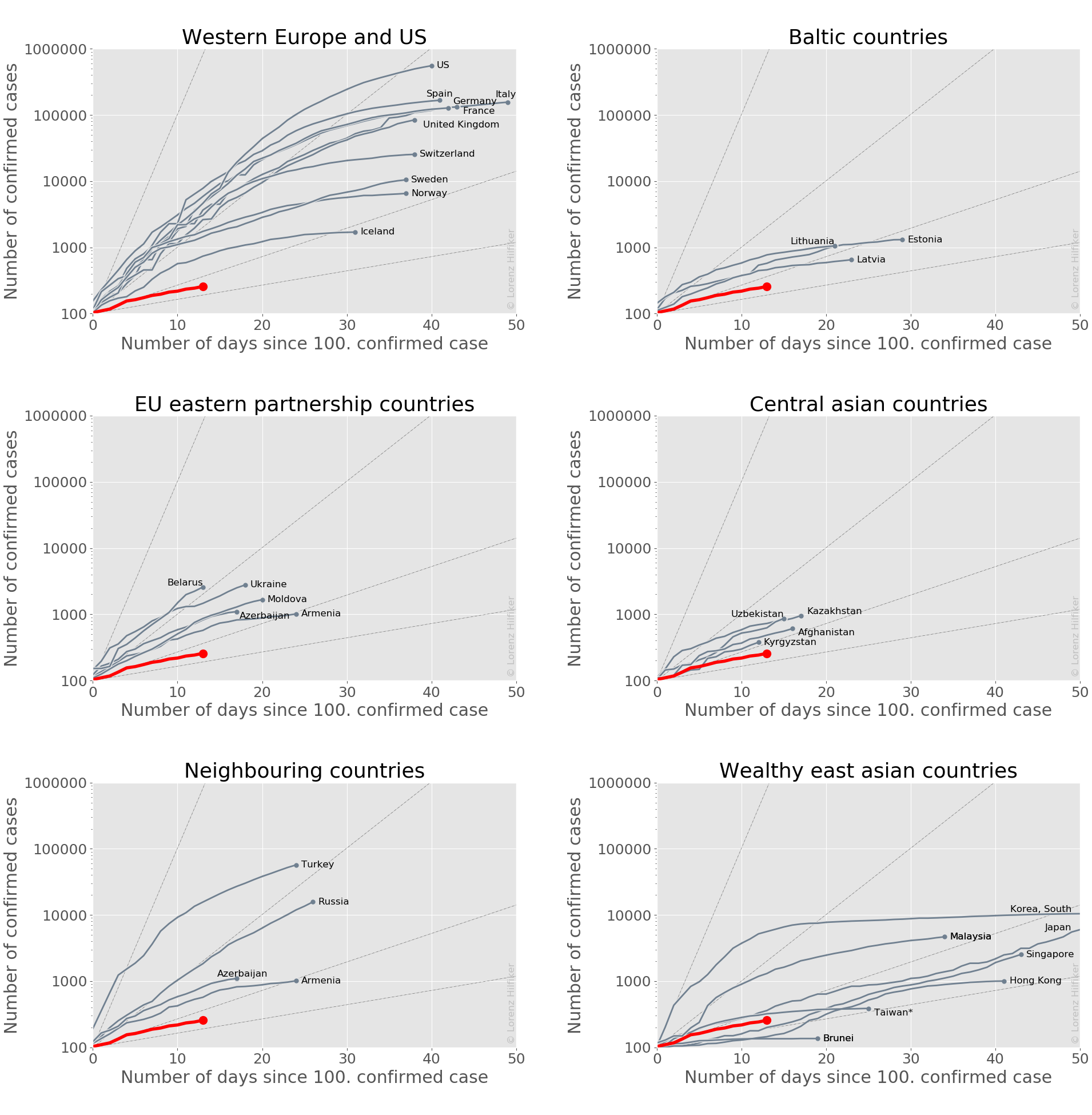
As COVID-19 infections in Georgia continue to grow slowly but steadily, we can now take a closer look at how this development compares with the outbreaks in other countries. While Georgia is on the same trajectory as Japan, it currently falls short of the benchmark set by some other wealthy east-Asian countries.
The first cases in Georgia were confirmed around the same time as in many European countries. Yet, the virus has so far spread considerably less than in most of the Western world.
For example, my native country Switzerland recorded its first case on 25 February, just one day before Georgia. As of 13 April, the tally for Switzerland stands at over 25,000 confirmed cases and over 1,100 fatalities, while Georgia has recorded merely 266 cases and three fatalities to date.
[Follow our rolling coverage of the coronavirus crisis in the Caucasus.]
Above is a chart of all countries which have reached 100 cumulative confirmed cases at least a week ago (thin grey lines).
We define day zero for each country as the day when the hundredth case was recorded. Georgia hit that number eleven days ago, and we can see in the chart, that it has managed to keep the speed of the spread relatively low since.
On average, it takes eight to nine days in Georgia for the number of confirmed cases to double. For countries at this early stage of an outbreak, that is a low number. However, Georgia’s almost straight line also indicates that the country is still in the phase of exponential growth.
Looking at other countries, China‘s outbreak gathered momentum back in January in the city of Wuhan. After an initial phase of very rapid spread (with cases doubling almost daily) Wuhan was placed under lockdown (day 4 on the chart), and drastic measures were taken all across the country. About a week later, we can see the onset of a flattening of China’s trajectory.
Iran, Western Europe and the US were next in line to battle the virus. Their reactions were markedly slower and less decisive than China’s. Correspondingly, the trajectories of those countries are set to peak later and at a higher level than China’s.
Among the countries with more recent outbreaks, Brazil and India do not seem to have been able to use the time factor to their advantage. Despite trailing Italy by almost three weeks, they seem very much on track to catch up with some of the worst-affected countries.
On quite a different trajectory we find Japan, which, due to its proximity to China, was affected very early on. Despite having little time to prepare, the country has managed to keep the transmission rate at a relatively low level, without suppressing the spread altogether.
Japan is a particularly interesting case from the Georgian perspective since Georgia is currently following the same trajectory with a delay of almost six weeks.
Most strikingly, Japan was able to slow down the epidemic despite avoiding comprehensive testing as well as some of the more restrictive measures other countries are relying on.
The New York Times writes that ‘part of Japan’s seeming resistance to infection may result from measures common in the culture, including frequent hand-washing and bowing instead of shaking hands. People are also much more likely to wear masks on trains and in public spaces.’
Next, we compare Georgia’s trajectory with some more specific groups of countries.

Georgia currently stands out among all but one of these groups as the country with the most successful response to the coronavirus. However, the benchmark clearly is the wealthy east Asian countries.
Infections in Japan, Singapore and Hong Kong have been growing exponentially, albeit at a much slower pace than in Europe before the countermeasures.
Taiwan and Brunei managed to almost completely suppress transmission from the beginning.
South Korea and Malaysia both experienced an explosive initial spread due to a single event (Christian and Muslim religious mass gatherings, respectively), but have since been able to slow it down.
South Korea in particular, thanks to early rigorous testing and radical tracing and tracking, has flattened the curve in record time.
It is perhaps worth noting that many of these countries had previous experience with outbreaks of highly infectious respiratory diseases (Hong Kong, Singapore and Taiwan with SARS in 2003, South Korea with MERS in 2015).
Can Georgia repeat Taiwan’s feat of capping the curve before it reaches 500 cases? Or will the upcoming Easter celebrations lead to a sudden spike in infections, throwing Georgia onto an entirely different trajectory?
If neither of these scenarios comes to pass, Georgia will continue to trail Japan, with infections growing slowly but steadily. While this may avert disaster for now, it also does not offer an exit strategy.
In Japan’s case, this has started to become a problem. Reports suggest a general ‘hygiene fatigue’ may have set in among the population. A recent new surge of infections prompted the government to change course and declare a state of emergency on 7 April.
A version of this article first appeared on 11 April 2020 on covidingeorgia.com.
All data used in this article is publicly available in the Johns Hopkins CSSE COVID-19 data repository.






